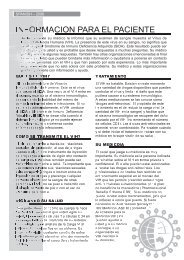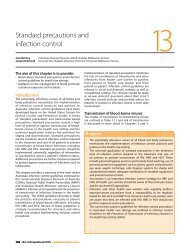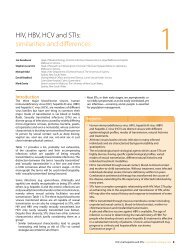B Positive – all you wanted to know about - ASHM
B Positive – all you wanted to know about - ASHM
B Positive – all you wanted to know about - ASHM
Create successful ePaper yourself
Turn your PDF publications into a flip-book with our unique Google optimized e-Paper software.
1 Prevalence and epidemiology of hepatitis B<br />
idus from accessing health services. education<br />
<strong>about</strong> hepatitis b risk fac<strong>to</strong>rs, increased access<br />
<strong>to</strong> HbV testing, and vaccination for idus are<br />
required <strong>to</strong> reduce the prevalence of HbV<br />
infection in this group.<br />
Men who have sex with men<br />
the prevalence of HbV infection in MsM<br />
is higher than in the general population.<br />
during the 1980s, the prevalence of HbV<br />
infection among MsM ranged from 34.0% <strong>to</strong><br />
81.7%, while Hbsag prevalence was 3.0% <strong>to</strong><br />
8.7%. 80-87 in the usa, an estimated 15<strong>–</strong>20% of<br />
<strong>all</strong> new HbV infections are in MsM. 88<br />
although an HbV vaccine has been available for<br />
two decades, coverage rates in MsM populations<br />
are low. studies have demonstrated coverage<br />
rates of 9% in the united Kingdom, 25<strong>–</strong>26%<br />
in the usa, and 53% in australia (sydney). 89-92<br />
a high prevalence of HbV infection is found<br />
among unvaccinated MsM: around 38.0% have<br />
markers of HbV infection and 4.2% are Hbsag<br />
positive. 89,93<br />
fac<strong>to</strong>rs associated with poor HbV vaccination<br />
coverage in MsM include a lack of <strong>know</strong>ledge<br />
of HbV infection and HbV vaccination, the high<br />
cost of vaccine, a low level of education and<br />
injecting drug use. 94-96<br />
unsafe behaviours, such as reusing injecting<br />
equipment and unprotected sex, continue <strong>to</strong><br />
be risk fac<strong>to</strong>rs for HbV infection among MsM.<br />
the duration of sexual activity, the number<br />
of partners, oro-anal and geni<strong>to</strong>-anal sexual<br />
contacts, the lifetime number of sexu<strong>all</strong>y<br />
transmissible infections, and injecting drug use<br />
are associated with HbV infection. 89,92,97<br />
the MsM population in australia is estimated<br />
at 300,000 (including men who identify as<br />
gay or homosexual and men who identify<br />
as heterosexual but have some his<strong>to</strong>ry of<br />
sexual contact with other men). 98 due <strong>to</strong> the<br />
availability of a HbV vaccine and the increased<br />
adoption of safer sex practices, the prevalence<br />
of HbV infection among MsM decreased<br />
from 61% in 1982 <strong>to</strong> 38% in 1991. 93 However,<br />
ongoing high-risk behaviour 99,100 and low<br />
18 b <strong>Positive</strong> <strong>–</strong> <strong>all</strong> <strong>you</strong> <strong>wanted</strong> <strong>to</strong> <strong>know</strong> <strong>about</strong> hepatitis b: a guide for primary care providers<br />
rates of HbV vaccination as outlined in recent<br />
studies 91 suggest that MsM remain a highrisk<br />
population. appropriate HbV vaccination<br />
strategies and education <strong>about</strong> the risk fac<strong>to</strong>rs<br />
for HbV transmission are required in order <strong>to</strong><br />
prevent infection among MsM.<br />
Increasing the burden of HBV-related<br />
liver disease<br />
since the 1970s, increased immigration from<br />
highly endemic HbV countries, particularly<br />
from the asia-Pacific region, has produced an<br />
increasing prevalence of chronic HbV infection<br />
in australia. although population-level HbV<br />
vaccination programs in highly endemic HbV<br />
countries will eventu<strong>all</strong>y reduce the HbV<br />
prevalence among immigrants <strong>to</strong> australia, the<br />
late introduction of these programs in many<br />
countries (e.g. in Vietnam and china in 2000)<br />
means the burden of chronic HbV infection is<br />
likely <strong>to</strong> continue <strong>to</strong> rise. this increasing burden<br />
of chronic HbV infection will produce an<br />
increasing incidence of advanced liver disease<br />
(including Hcc) over the coming two decades.<br />
for example, among australians of chinese<br />
origin, the number of HbV-related Hcc cases<br />
is projected <strong>to</strong> more than double over the<br />
period 2005 <strong>to</strong> 2025 (see figure 1.4). 5 similar<br />
trends are expected for other high-risk groups<br />
such as Vietnamese-born australians. However,<br />
the improved uptake of HbV therapy has the<br />
potential <strong>to</strong> limit these trends.<br />
Public health response <strong>to</strong> hepatitis B<br />
While effective national strategies for HiV and<br />
hepatitis c have been adopted, the public<br />
health response <strong>to</strong> HbV is very limited and<br />
relies predominantly on universal infant<br />
hepatitis b vaccination. the number of people<br />
with hepatitis b is projected <strong>to</strong> increase due <strong>to</strong><br />
continuing immigration from high endemic<br />
countries and sub-optimal vaccine coverage<br />
among high-risk populations (idus, MsM,<br />
aboriginal and <strong>to</strong>rres strait islander peoples).<br />
<strong>to</strong> reduce the impact of hepatitis b infection, a<br />
national strategy should be developed focusing<br />
on enhanced HbV prevention, education and<br />
improvement of diagnosis, treatment and care.






